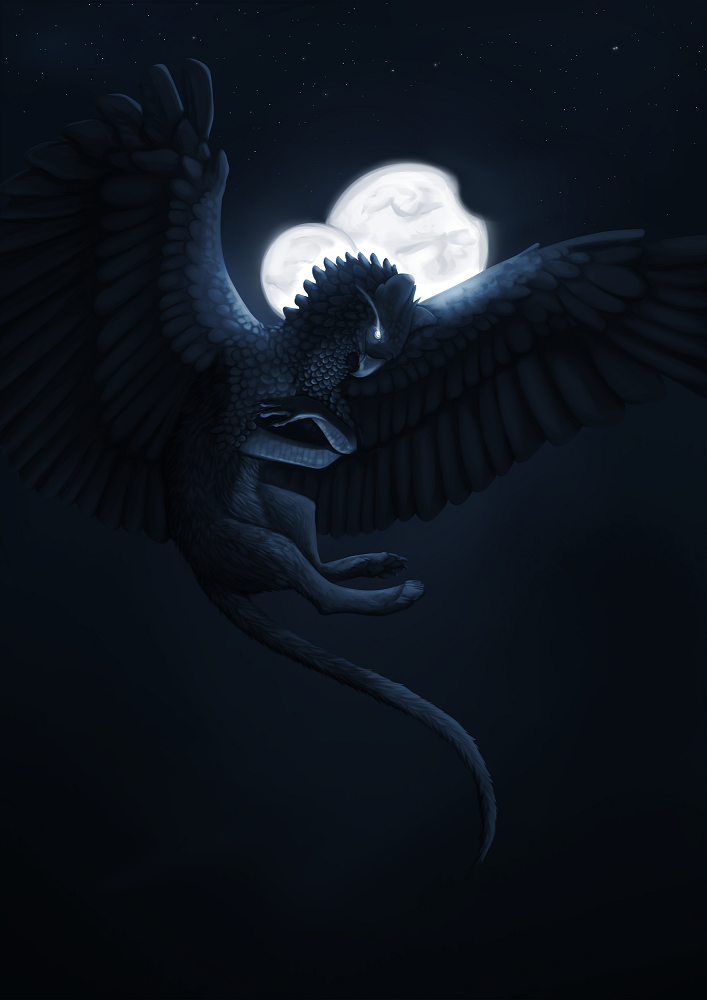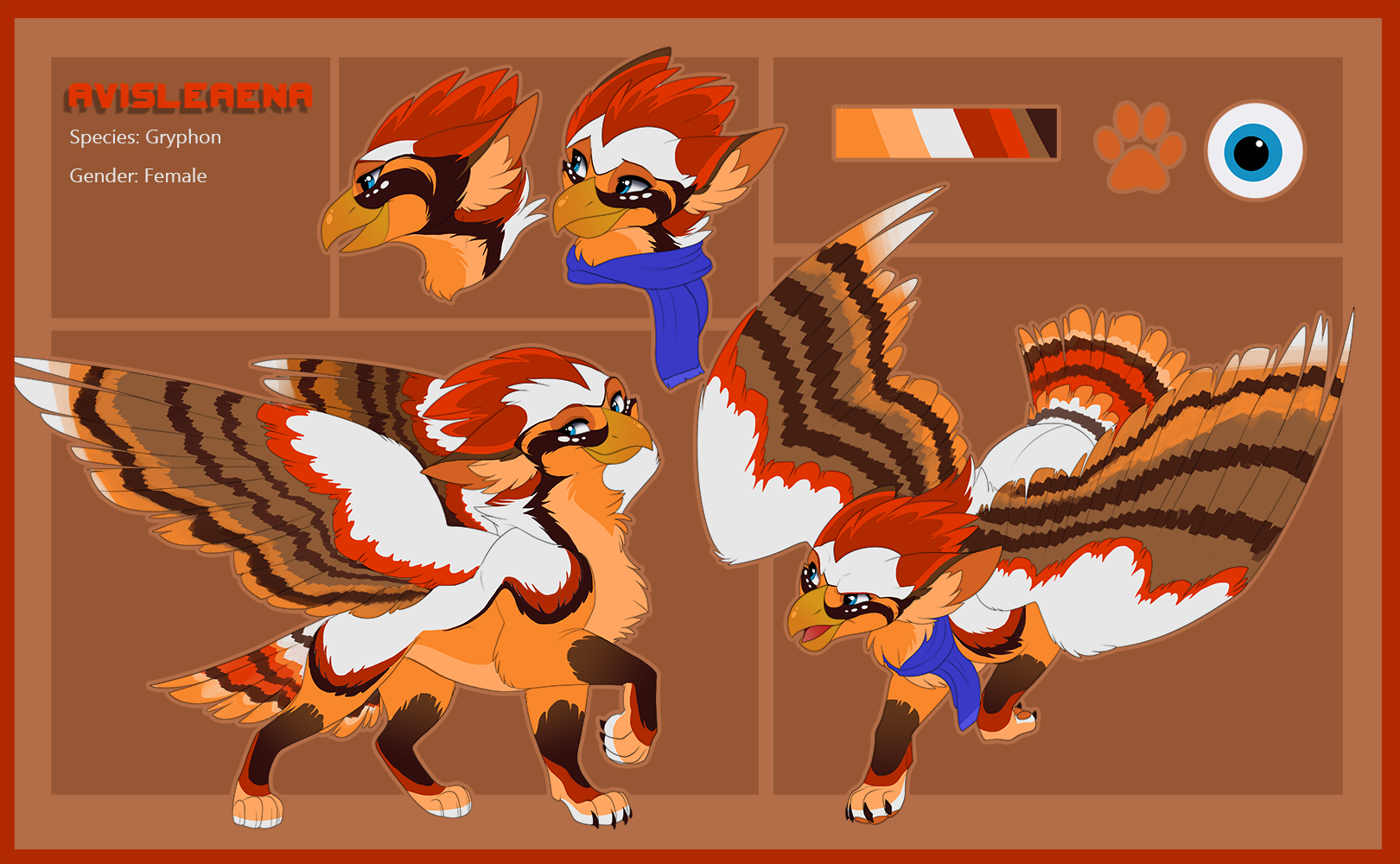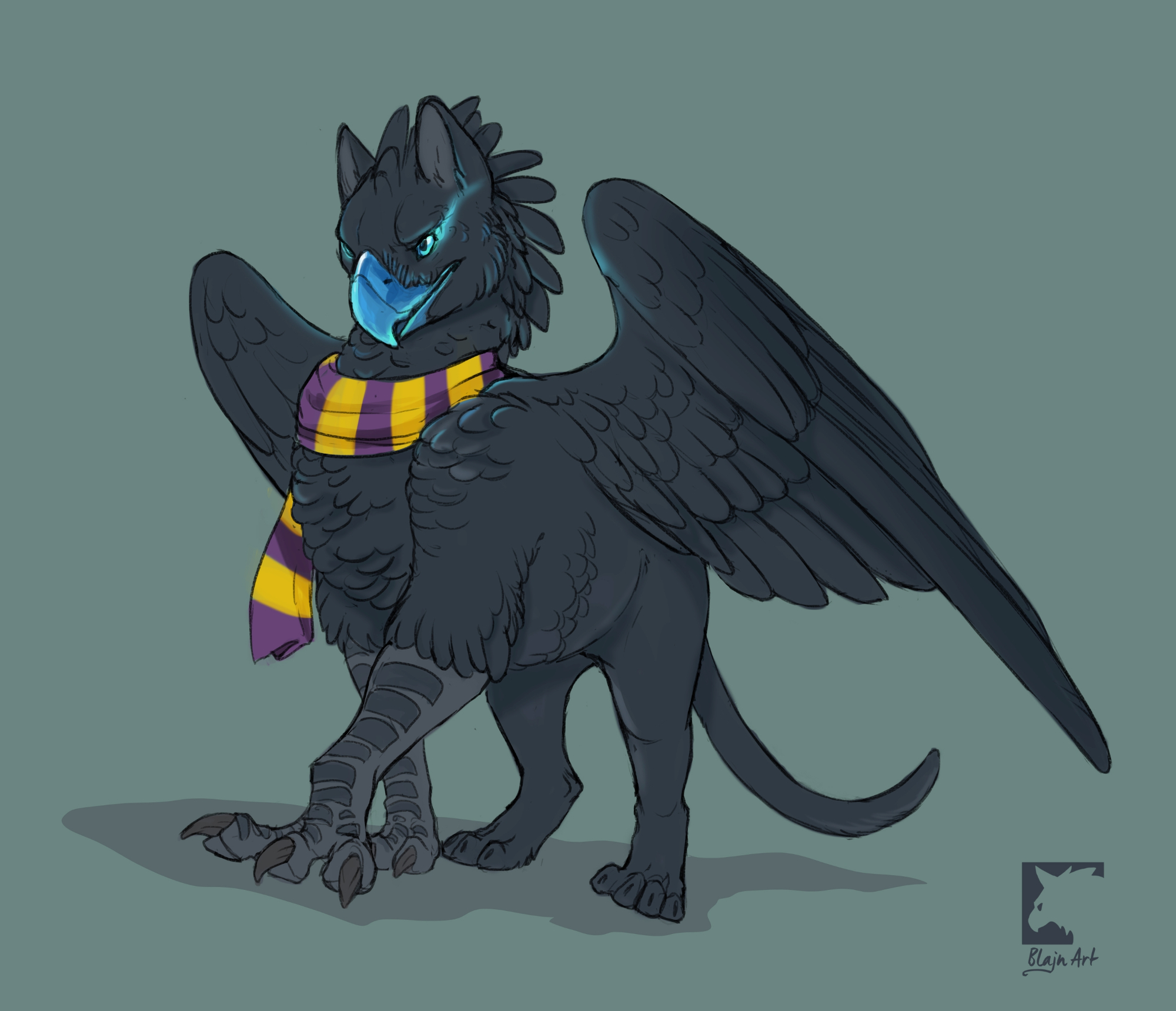Gryphons
If you would have come to me before saying, "Avi, you have to leave your mate to save your tribe from inner turmoil and possible war before the next Competitions." I would have laughed. As it is right now, my heart aches at the mere thought of going back. I know I probably could return and be accepted, but I don't think I have the strength to face everyone... yet.Gryphons vary heavily from one another and while some patterns and color combinations are more common than the others, the main difference is based on their lifestyle cycle - Nocturnal and Diurnal both of which hate Dragons equally as much for they have a nasty habit of stealing their precious eggs and offspring. Nocturnal gryphons are as their name suggest more active throughout the night and nest during the day. The opposite is true for Diurnal. While their society is tribalistic and only rarely live a solitary life, most of the gryphon tribes form from solely Diurnal or Nocturnal individuals. Tribes that contains both types are rare but lately become more commonplace out of necessity for protection. Appearance wise, gryphons have part feline features and part avian features that are heavily apparent in exactly half of their body structure. Diurnal gryphons are avian-like from top side and feline-like from bottom side, their coloration tends to be brighter. Nocturnal gryphons have avian-like features from front side and feline-like from back side instead, their colouration tends to be darker.
Basic Information
Anatomy
Six limbs - two wings and four paws. Nocturnal gryphons have avian-like forelegs, Diurnal gryphons have all paws feline-like. A beak forms from the front of their head used to tear apart flesh as well as crunching plantlife. Wings are covered in feathers capable of flight. Their tails are leonine for Nocturnal gryphons but for Diurnal it forms an avian-like fan, generally adorned in multiple colours.
Genetics and Reproduction
Varies heavily, Noctunal gryphons on average gestate 2-3 eggs for two weeks, hatching occurs after 40 days.
Diurnal gryphons lay 3-4 eggs after 20 days of gestation and clutching occurs on 30th day. Another specific feature is that female Diurnal gryphons must mate repeatedly with the same partner in order for them to be able to conceive a clutch, this is called Partnering. Most gryphonesses are highly sexually active, yet as long as they switch partners, they will not become fertile.
Partnering on average takes five days, during which mating repeatedly should occur within a timespan of 48 hours for it to be successful.
Growth Rate & Stages
Diurnal gryphlets reach adulthood in 7 years, although females become fertile usually on their 9th year.
Nocturnal gryphlets reach adulthood on their 8th year.
Ecology and Habitats
Most gryphons live in savannas or in places with easy access to lowlands. Some tribes may live in a forested or mountainous area, but those tend to be of smaller size. Dragons are their natural enemies, and so they avoid them as much as possible.
Dietary Needs and Habits
Both types of gryphons eat vegetables, insects, rodents and smaller mammals. Only specifically trained individuals in a pack hunt for larger game. Some tribes posses a rudimentary means of cold storage or drying out their food to make it last longer.
Biological Cycle
Gryphons shed a lot of feathers and fur. All the time. But older gryphons nearing their 30th year mark tend to grey out and lose some of their feathers, resulting in bald spots.
Additional Information
Social Structure
Tribalistic. Annual non-lethal competitions of various disciplines testing both body and mind are held to see who is the most capable individual to lead the tribe. The tribe leader also chooses their second in command - privilege that generally falls upon their sibling, trusted friend or mate.
Each tribe leader is respected by the members of its community and can overrule any command given by their predecessor. As such, the Competitions are held at the start of the new year, week after the Celebration of Passing has ended to mark the upcoming changes. During the time of war or great strife, Competitions may also be delayed or cancelled until the war ends.
Nobility of the gryphon kind is very rare, as these individuals generally hail from families that performed heroic deeds in the past. Not very many of these live up to this day, many perished during the Conquering at the claws of dragonkind.
Domestication
Dragons domesticate gryphons by stealing them from their parents when they are very young. Domesticate gryphons tend to serve their masters as couriers or servants but once domesticated, it is near-impossible for a gryphon to integrate back into a gryphon tribe where it came from.
Gryphons themselves are averse to domestication or generally "having pets" of any kind. Although it is still possible to see them in company with Rocs and Wild cats.
Uses, Products & Exploitation
Gryphon feathers are oftentimes used in crafting various decorations or clothes by dragons, yet finding such items tends to be difficult and risky. Stray feathers are sometimes found here and there along the gryphon territories but dragons tend to avoid encroaching there - as this could be seen as an open provocation and they may end up being attacked.
Facial characteristics
The most prominent parts of a gryphon face is a beak - those come in many different shapes and forms. Some are curved down, others are lengthy with a sharp end, the rest may have a small one good only for picking fruits. Ears are prominently long and may end in a tuft. Some gryphons also possess prominent eyelashes or feathers along their cheeks.
Geographic Origin and Distribution
Generally located along the south-eastern parts of the Continent in colder climates and higher elevations
Perception and Sensory Capabilities
Great depth of perception and sight, good hearing, some Nocturnal gryphons have Dreamgliding capabilities.
Symbiotic and Parasitic organisms
Most gryphon tribes revere Rocs as their forefathers and sometimes set Roc's feathers in their own crests to decorate themselves. Wild cats are also considered their eartly forefathers, yet they tend to be only respected, rather than zealously revered. No gryphon would willingly hurt or hunt a Roc or Wild cat without provocation, although cases, where Wild cats encroached on and ignored gryphon tribe borders and were summarily driven out, also exist.
It is assumed gryphons know the langauge of Wild cats and Rocs and are capable of limited exchange of information. In fact, Wild cats that bonded or allied with gryphons are given a feather that is braided in their fur and proudly worn as a symbol of their friendship with that specific gryphon.
In general, Diurnals tend to matters involving Rocs and Nocturnals meet with Wild cats, simply because the former species is active throughout the day and latter tends to be awake at night.
Civilization and Culture
Naming Traditions
Generally, female names start with vowels, male names start with consonant. The rule is not strictly followed and some female-sounding names were given to males and vice-versa in the past.
Male gryphon names: Falth, Roo, Kree, Strolk, Skoof Female gryphon names: Avisleaena, Esk, Inkrii, Iopolina, Arkrarena
Male gryphon names: Falth, Roo, Kree, Strolk, Skoof Female gryphon names: Avisleaena, Esk, Inkrii, Iopolina, Arkrarena
Beauty Ideals
Singing, dancing, performing, air-acrobacy or ballad-writing are amongst the most sought-after activities a gryphon may perform. Individuals that are exceptionally talented in any of the arts generally have no shortage of admirers.
Gender Ideals
While ideals differ amongst Diurnals and Nocturnals, in general gryphons prefer to look for individuals that are yet without any prior family, young, and very open. This is twice as true for females, who generally have a harder time finding a new mate after they raise their first clutch.
Courtship Ideals
Many courtships amongst Diurnals start with a few sleepless nights and days with the few individuals a gryphon finds intriguing. Because of Partnering, their sexual life tends to be very open and prolific, sometimes going as far as mating being a part of maintaining friendships amongst a group of unmated young gryphons. It may take years for young gryphons to wish to settle and actively start a family with someone, by which point they generally utilize more reason rather than impulse on who to claim as a mate.
For Nocturnals, the issue of sexual activity is far more reserved to the special occasion of starting a family. As such, their courting requires a few months, sometimes years of mutual trust before such a step is undertaken.
Courting itself involves impressing the member of one's desires with dances, songs, feats of physical prowess, crafted items, storytelling, mutual preening and/or gifts. Diurnals do not consider sex as a part of courting.
Relationship Ideals
Once mated and started a family, gryphons tend to stay together for a very long time, no matter if Nocturnals or Diurnals. An absolute ideal would be to stay bonded for a lifetime - something that many couples strive for.
Major Language Groups and Dialects
Gryphons can utilize mimickry of sounds to get a limited responses from nearby avians or felines. The more intelligent Rocs and Wild cats can reply to more specific questions.
Common Dress Code
It is very common for gryphons to decorate themselves with at least one item made out of wool, leather, hide, fur or to wear a Roc feather. A gryphon without any such decoration would be seen as a youngster or impolitely "naked"
Culture and Cultural Heritage
Winder is an old gryphon-specific language.
Common Customs, Traditions and Rituals
Beyond's eve is a gryphon specific ritual done to commemorate all fellow tribesmen that died throughout the year.
Common Taboos
Any dealings with Dragons are generally frowned upon, if not outright banned by their current Tribe leader.
Genetic Descendants
Scientific Name
Midrast Gryffinus
Lifespan
50
Conservation Status
Gryphons of Midrast Wain would be considered by today's standards NT - Near Threatened. Their numbers are not swelling, however, they are also not in any immediate danger of declining rapidly. This is oftentimes attributed to disagreements between smaller tribes and infighting. Gryphon situation improved ever since Air dragons trades of gryphon eggs was banned through Greengrasp accord.
Average Height
1.7 - 2.0 m
Average Weight
140 - 170 kg
Average Length
2.5 m
Average Physique
Muscular and well-built. They are capable of quickly gain or lose muscles if fed properly/improperly.
Falth - Nocturnal gryphon

by Kaarhai
Remove these ads. Join the Worldbuilders Guild











Lovely original art, and great article overall. I love the differentiation between gryphon kinds being prominently time-of-day based! Well done!
Thank you! Glad you like it! <3